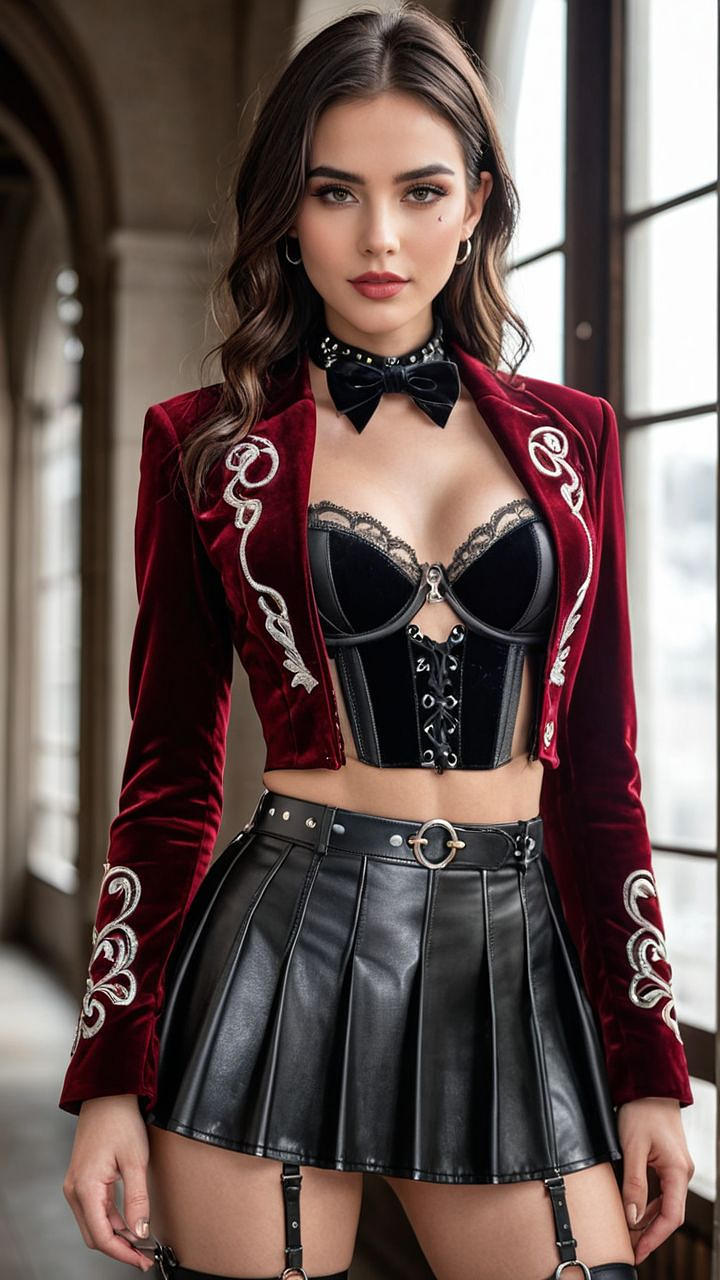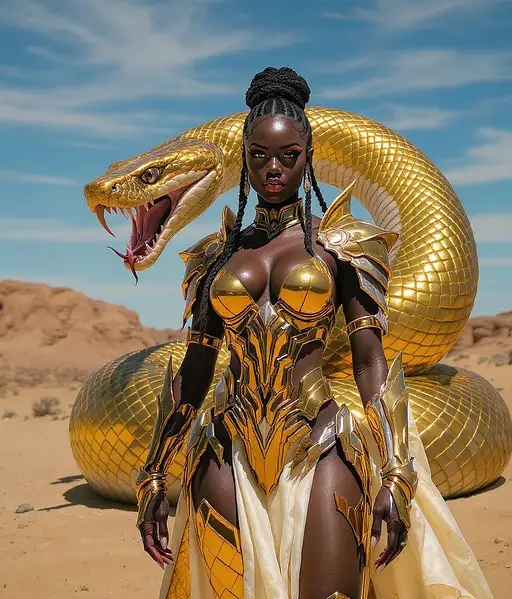


9 months ago
In this vivid portrait, a young man of Korean-Caucasian descent stands confidently, his presence nearly tangible. Medium-length, slightly wavy black hair, flecked with strands of white, frames his face in a natural tousle that brushes just below his ears, lending him an air of rugged charm. His skin, a warm golden-beige, radiates youth and confidence, setting the stage for his most striking features: intense, expressive green eyes, slightly tilted upwards at the corners, that convey a resolute focus and determination. The subject is depicted at a statuesque 6’4” with a lean, muscular build, the contours of an inverted triangle visible under a snugly fitting t-shirt that hints at a well-toned physique. His face is an intricate blend of strong yet soft angles; almond-shaped monolid eyes sit beneath thick eyebrows, high cheekbones rise under the skin, and his jawline is both strong and softly defined. His lips, full with a well-defined Cupid’s bow, are relaxed yet poised. Adorning him are several piercings—a discreet tongue piercing that speaks to a hint of rebellion, an industrial piercing in his left ear, and additional piercings in both lobes and the upper lobes, coupled with a single eyebrow piercing on his left. The light does not catch the tongue piercing, tucked away as it is, but the metallic hints on his ears and eyebrow add a subtle glint to his aesthetic. His fingers, calloused from strings of a guitar, suggest a life rich with music. The man wears various pieces of jewelry that complement his casual yet deliberate style, each piece adding to the narrative of his detailed and dynamic character. This painting not only captures the man’s physical attributes but also suggests his personality—a blend of strength, artistry, and the quiet depth of his gaze. Style: anime realism

4 months ago
A striking young woman stands resolute against the downpour-soaked cityscape, her vibrant presence a beacon of rebellion amidst the rain-lashed streets. Her messy, bubblegum pink hair â shot through with neon magenta highlights that seem to pulse with an inner light â is plastered to one side of her head, framing her heart-shaped face and gleaming silver earrings as she gazes out into the night. A sleek black jacket clings to her shoulders, its dark purple shadows a striking contrast to the vibrant hues that dance across her hair and the neon advertisements that line the streets behind her. A crisp white t-shirt clings to her toned physique, its wet fabric accentuating every curve of her body as she stands steadfast against the torrential rain.

4 months ago
A stylized, retro-futuristic illustration inspired by the iconic anime Akira. The composition features a lone figure in a red futuristic biker suit walking forward, viewed from behind. On the back of the suit is a distinctive blue and white capsule emblem. Ahead of him is a sleek, high-tech red motorcycle with detailed decals and a large, curved windshield, positioned slightly from the side. Both the figure and the bike are perfectly centered over a massive red capital letter "A" that dominates the background. The color palette is dominated by reds, creams, and blacks, with clean, sharp shadows and a minimalist background. The overall tone is serious and cinematic, capturing a sense of iconic sci-fi rebellion and cyberpunk energy.

9 months ago
a full-body view of a noblewoman from the Middle Ages of England, elegantly poised in a grand, dimly lit medieval hall. She is dressed in a luxurious, sheer white gown made of delicate lace, its fabric flowing softly around her figure. The gown features a deep V-neckline, revealing a striking and intricate red dragon tattoo that begins below her collarbone and extends gracefully down her throat to her sternum. The bold tattoo creates a striking contrast against her otherwise quiet and shy demeanor, adding an air of mystery and rebellion to her noble elegance. Underneath the sheer gown, an intricately designed lace swimwear set in bright red and adorned with royal blue gems and crystals glistens in the dim candlelight. The gems reflect her wealth and high status, their vibrant colors adding a rich, opulent flair to her attire. Her bare feet rest on the cold stone floor, further emphasizing her natural and grounded elegance. The background is a grand medieval hall, with towering stone walls, intricate tapestries, and softly flickering candlelight that casts dramatic shadows across the scene. The warm, golden glow enhances the texture of the stone and lace, while drawing attention to the subtle glimmer of the crystals and the vivid red of her tattoo. Her expression is a captivating mix of strength and mystery, her demeanor both noble and rebellious, embodying the contrast between tradition and individuality. The lighting is soft and diffused, highlighting the intricate lace patterns of her gown, the delicate design of her jewelry, and the bold lines of her tattoo. Rendered in ultra-high detail, this scene captures the essence of medieval nobility with an edgy, modern twist, blending historical elegance with unexpected boldness for a truly unique and visually stunning composition.
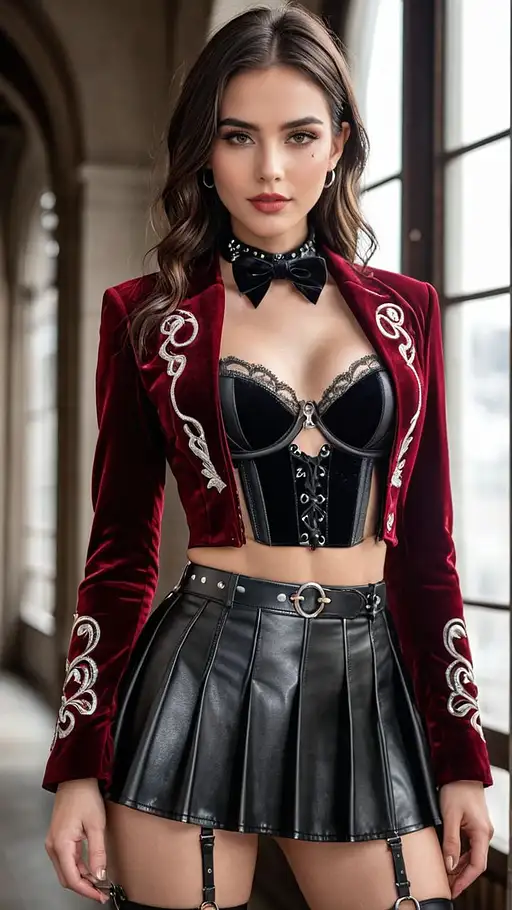
3 months ago
Cropped velvet jacket in wine red embroidered with steel gray blade motifs across sleeves and collar, high-waisted pleated skirt marked with bold painterly bloodstroke splatters along the hemline, mock-lingerie top featuring heart-shaped cutouts along the bodice and structured corsetry seams, satin neck bow tied at the throat with a dangling silver dagger pendant, thigh strap holstering a pair of metallic mini shears angled like hidden blades, overall aesthetic balancing femme noir rebellion and precision-cut fashion violence

9 months ago
A striking and captivating illustration of a Japanese punk woman, adorned with traditional tattoos that narrate ancient tales. Her body is a canvas of vivid colors and intricate designs, reflecting the elegance of traditional Japanese archetypes. The punk subculture is evident in her spiky hair, piercings, and edgy clothing - a unique blend of rebellion and refinement. She stands tall, her posture exuding confidence and defiance, her intense gaze drawing you into her world. The background is a vibrant blend of urban cityscape and natural elements, with a sense of raw emotion and rebellious spirit. The artistic style combines airbrush-anime techniques, celebrating the audacious beauty of Japanese youth. Toni Angelchovski, is legibly and neatly written in the bottom-right corner of the image. Date: 14/05/24.
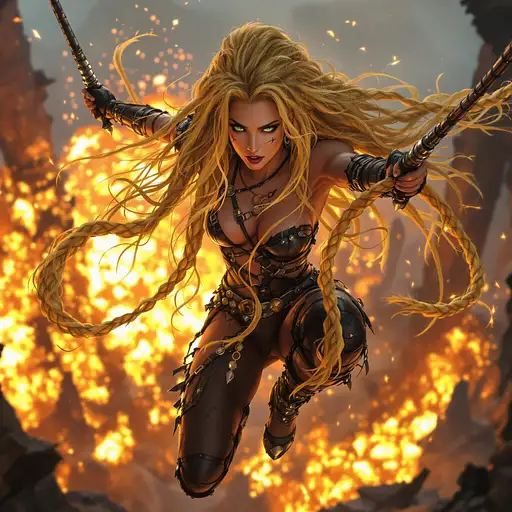
3 months ago
apunzel as a wild, battle-scarred warrior queen. Her impossibly long golden hair is braided into thick, weaponized whips, studded with metal rings and sharpened crystal tips. She wears an asymmetrical leather combat bodysuit—torn and wrapped in strands of her glowing hair like golden armor. Her deep green eyes burn with rebellion, framed by soot and sweat. She swings from tower ruins as explosions erupt behind her, using her hair like grappling ropes. Gorgeous, fierce, and untamed—she’s not waiting for a prince. She’s here to tear the tower down with her own hands, one strand at a time.
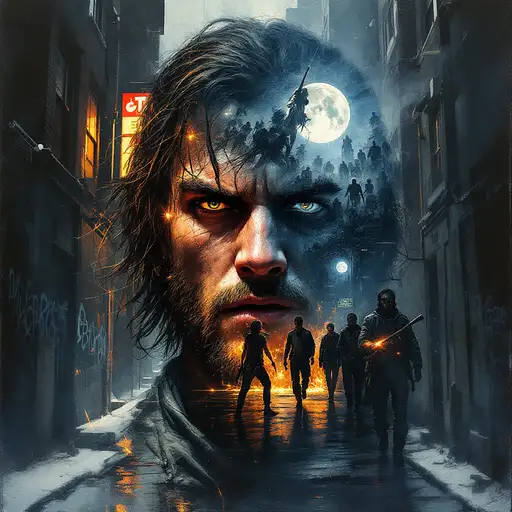
7 months ago
Craft a dynamic and emotionally charged oil painting that uses the double exposure technique to capture the raw energy, unity, and struggles of The Warriors. The central figure should be one of the Warriors, such as Swan, his face half-translucent and fierce, embodying both the individual and collective spirit of the gang. His expression should be filled with determination and defiance, while his figure dissolves into the gritty, chaotic streets of 1970s New York City—dark alleys, graffiti-tagged walls, and the stark silhouettes of neon lights. His features should bleed into the urban landscape, as though he is both a part of the city and a symbol of rebellion against it. Inside his form, a web of interconnected images from the Warriors' journey should emerge: the haunting image of the baseball bat-wielding Rogues, the fire-lit glow of the moonlit escape across subway tunnels, and the strong camaraderie of the Warriors themselves, seen through their shared struggles and brotherhood. The double exposure should seamlessly integrate these elements into his figure, illustrating the tension between individual survival and the unbreakable bond of the gang as they face overwhelming odds together. The color palette should reflect the gritty urban feel of the film, with cool blues, grays, and blacks contrasted with the neon oranges, reds, and greens of the streetlights and graffiti. The atmosphere should feel electric, filled with an undercurrent of danger, defiance, and unspoken loyalty. The oil painting should evoke a sense of movement—like a snapshot of the Warriors running through the night, the harsh cityscape blurring into their form, and the struggle against the forces that threaten to tear them apart. This double exposure composition should not only explore the Warriors' journey through the hostile streets but also the emotional and psychological depth of their fight for survival and unity. The contrast between the rawness of their environment and the bond they share should be at the heart of this painting, encapsulating the spirit of The Warriors as a timeless symbol of resilience and brotherhood.

4 months ago
Create a vibrant RPG scene inspired by Final Fantasy VII, featuring Tifa Lockhart in a dynamic action pose. She stands confidently in her iconic black tank top and brown shorts, showcasing her athletic build, with her long, dark hair flowing behind her. Her gloved fists are raised, ready for combat, highlighting her martial arts prowess. The background reveals the bustling streets of Midgar, with towering steel structures and neon lights casting a moody glow. A hint of the Shinra headquarters looms in the distance, symbolizing the oppressive corporate power. Tifa's signature items, such as her leather gloves and the Materia orb glowing softly at her side, add depth to the scene. The atmosphere is charged with determination and resilience, capturing the spirit of rebellion against tyranny. Utilize a blend of anime-inspired art style and detailed textures to evoke the rich, immersive world of Final Fantasy VII.
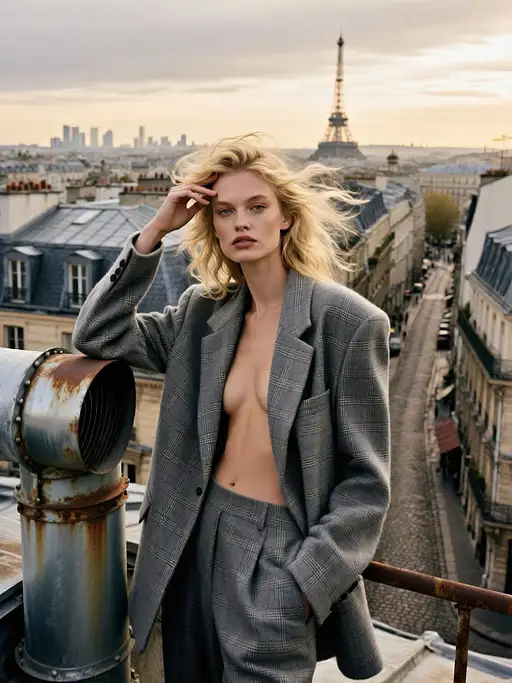
17 days ago
A stylish blonde woman with messy, windswept hair poses confidently on a rooftop in Paris, overlooking the cityscape with classic Haussmann-style buildings and narrow streets below. She wears an oversized, tailored gray checkered blazer left open to reveal her bare chest, exuding bold fashion and urban elegance. Her hand rests gently on her temple, gazing directly at the camera with a serene yet powerful expression. The lighting is soft and natural, overcast sky, creating a moody, cinematic atmosphere. High-fashion editorial style, modern and sophisticated, with a touch of rebellion. Detailed textures: fabric of the blazer, metal ventilation pipe she leans on, and the urban architecture in the background. Shot in high resolution, 8K, realistic photography.
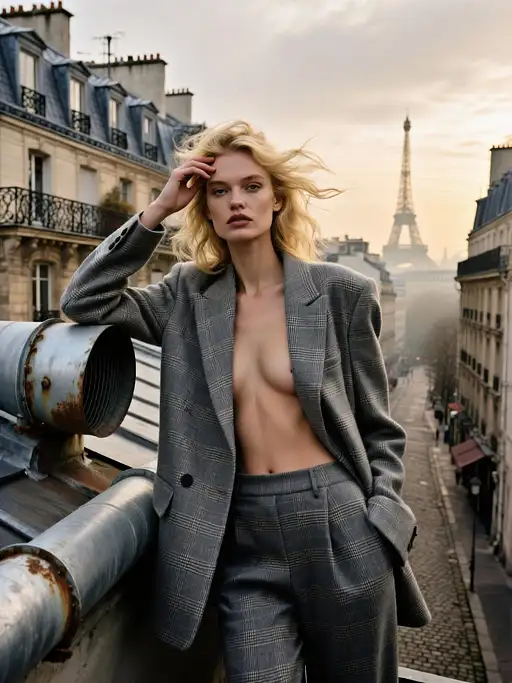
17 days ago
A stylish blonde woman with messy, windswept hair poses confidently on a rooftop in Paris, overlooking the cityscape with classic Haussmann-style buildings and narrow streets below. She wears an oversized, tailored gray checkered blazer left open to reveal her bare chest, exuding bold fashion and urban elegance. Her hand rests gently on her temple, gazing directly at the camera with a serene yet powerful expression. The lighting is soft and natural, overcast sky, creating a moody, cinematic atmosphere. High-fashion editorial style, modern and sophisticated, with a touch of rebellion. Detailed textures: fabric of the blazer, metal ventilation pipe she leans on, and the urban architecture in the background. Shot in high resolution, 8K, realistic photography.
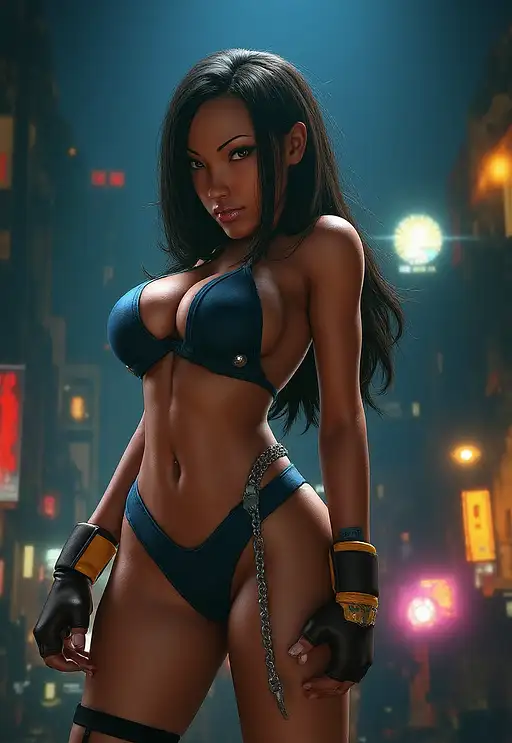
4 months ago
Create a vibrant RPG scene inspired by Final Fantasy VII, featuring Tifa Lockhart in a dynamic action pose. She stands confidently in her iconic black tank top and brown shorts, showcasing her athletic build, with her long, dark hair flowing behind her. Her gloved fists are raised, ready for combat, highlighting her martial arts prowess. The background reveals the bustling streets of Midgar, with towering steel structures and neon lights casting a moody glow. A hint of the Shinra headquarters looms in the distance, symbolizing the oppressive corporate power. Tifa's signature items, such as her leather gloves and the Materia orb glowing softly at her side, add depth to the scene. The atmosphere is charged with determination and resilience, capturing the spirit of rebellion against tyranny. Utilize a blend of anime-inspired art style and detailed textures to evoke the rich, immersive world of Final Fantasy VII.

9 months ago
A vibrant, high-contrast portrait of Miley Cyrus, a Caucasian woman in her early 30s, standing confidently with a playful yet rebellious stance. She wears a bold, glittering silver jumpsuit with a deep V-neckline, paired with knee-high metallic boots. Her platinum blonde hair cascades in loose waves, framing her expressive face. Her makeup is dramatic: smoky eyes with silver glitter accents, bold red lips, and a dewy glow. Her hands are raised mid-dance move, fingers splayed, exuding energy and freedom. The background is a neon-lit cityscape at night, with glowing pinks, blues, and purples reflecting off wet pavement. The atmosphere is electric, with a mix of retro 80s and futuristic cyberpunk vibes. The lighting is dynamic, with sharp highlights and deep shadows, emphasizing her confident expression and the texture of her outfit. The perspective is a mid-shot, capturing her full body and the vibrant environment behind her. The mood is celebratory and bold, with a touch of edgy rebellion. Style: modern pop art with a touch of surrealism. Colors: neon, metallic, and high-contrast tones.

7 months ago
a full-body view of a noblewoman from the Middle Ages of England, elegantly poised in a grand, dimly lit medieval hall. She is dressed in a luxurious, sheer white gown made of delicate lace, its fabric flowing softly around her figure. The gown features a deep V-neckline, revealing a striking and intricate red dragon tattoo that begins below her collarbone and extends gracefully down her throat to her sternum. The bold tattoo creates a striking contrast against her otherwise quiet and shy demeanor, adding an air of mystery and rebellion to her noble elegance. Underneath the sheer gown, an intricately designed lace swimwear set in bright red and adorned with royal blue gems and crystals glistens in the dim candlelight. The gems reflect her wealth and high status, their vibrant colors adding a rich, opulent flair to her attire. Her bare feet rest on the cold stone floor, further emphasizing her natural and grounded elegance. The background is a grand medieval hall, with towering stone walls, intricate tapestries, and softly flickering candlelight that casts dramatic shadows across the scene. The warm, golden glow enhances the texture of the stone and lace, while drawing attention to the subtle glimmer of the crystals and the vivid red of her tattoo. Her expression is a captivating mix of strength and mystery, her demeanor both noble and rebellious, embodying the contrast between tradition and individuality. The lighting is soft and diffused, highlighting the intricate lace patterns of her gown, the delicate design of her jewelry, and the bold lines of her tattoo. Rendered in ultra-high detail, this scene captures the essence of medieval nobility with an edgy, modern twist, blending historical elegance with unexpected boldness for a truly unique and visually stunning composition.

5 months ago
[EXT. RUINED STREET - NIGHT] - Cinematic, gritty, rain-slicked concrete. Flickering emergency lights cast long, distorted shadows. JOHN CONNOR (16) stands powerfully amidst the decay. He’s wearing a dark grey, scuffed, athletic sneaker. He’s also wearing dark blue jeans – faded and ripped, the denim worn thin in places. He’s wearing a dark grey, slightly worn, multi-pocketed military-style camouflaged jacket. Beneath it, a dark grey, long-sleeved t-shirt, with the word SKYNET on it slightly faded and worn. The sleeves are rolled up to his elbows. His hair is exactly how it was in the movie , and dark brown – deliberately messy and uneven. His expression is a mixture of grim determination and cold, simmering anger. Rain plasters his dark hair to his forehead. The background is filled with the skeletal remains of machinery and shattered windows. Focus: John Connor’s intense gaze, the texture of his clothing, the palpable atmosphere of urban decay and suppressed rebellion. [SLOW ZOOM] - Dramatic lighting, volumetric lighting, hyperrealistic, 8k, cinematic, photorealistic, highly detailed, moody, apocalyptic, dystopian, rebellious, defiant. Style: Greg Rutkowski, Simon Stålenhag, Blade Runner. Negative prompt: happy, smiling, clean, bright, sterile, idealized, romantic, cartoon, anime.
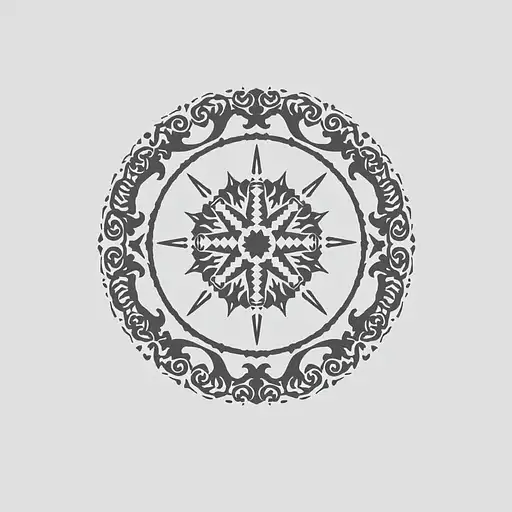
5 months ago
Make a simple LOGO/Symbol that represents the following information.. History of the Hakka People - Key Points Here's a breakdown of Hakka history in point form, covering their origins, migrations, culture, and modern situation: **I. Origins & Early History (Pre-Song Dynasty - Before 960 AD)** * **Han Chinese Roots:** The Hakka are a subgroup of the Han Chinese, *not* a separate ethnic group. Their name “Hakka” (客家) literally means “guest families.” * **Northern Origins:** Most scholars believe the Hakka originated from areas of North and Central China (Henan, Shanxi, Shaanxi) during periods of upheaval. * **Multiple Migrations:** They weren’t a single migration, but *waves* of migration southward over centuries, starting as early as the Qin and Han dynasties (221 BC – 220 AD). * **Avoiding Conflict:** These migrations were often driven by political instability, war, and famine. The Hakka tended to move *away* from conflict, not to conquer. * **Early Settlers in Jiangxi:** The Jiangxi province became an early and important staging ground for their southern migrations. **II. The Long Migration & Settlement (Song - Ming Dynasties - 960 - 1644 AD)** * **Southern Migration Intensifies:** The Song Dynasty (960-1279) saw a significant acceleration of Hakka migration southwards. * **Conflict with Existing Populations:** As they moved south, the Hakka often settled in marginal lands or areas already inhabited by other groups (including other Han Chinese, and minority groups like the She and Yao). This led to frequent conflicts and clashes. * **“Guest” Status:** They were often seen as outsiders or "guests" by the existing populations, hence the name “Hakka.” They were often denied full integration. * **Settlement in Guangdong, Fujian, Jiangxi:** The Hakka eventually settled primarily in the provinces of Guangdong, Fujian, and Jiangxi, as well as parts of Sichuan, Hunan, and Guangxi. * **Fortified Villages (Weitou):** Due to constant threats and conflict, the Hakka developed a unique architectural style – fortified, circular villages known as *Weitou* (围头). These served as both homes and defensive structures. * **Development of Distinct Culture:** During this period of migration and isolation, the Hakka developed their own distinct language, customs, and traditions. **III. Qing Dynasty & Modern Era (1644 - Present)** * **Qing Dynasty Stability:** The Qing Dynasty (1644-1912) brought a period of relative stability, allowing the Hakka to consolidate their settlements and develop their economy. * **Continued Marginalization:** However, they remained largely marginalized from mainstream Chinese society, often facing discrimination and economic hardship. * **Taiping Rebellion (1850-1864):** A significant number of Hakka joined the Taiping Rebellion, a large-scale uprising against the Qing Dynasty. This further complicated their relationship with the central government. * **Overseas Migration:** In the late 19th and early 20th centuries, many Hakka emigrated overseas, primarily to Southeast Asia (Malaysia, Indonesia, Thailand, Singapore) and other parts of the world. They became successful merchants and entrepreneurs. * **Communist Revolution (1949):** After the Communist Revolution in 1949, the Hakka were initially seen as a potentially rebellious group due to their history of independence and resistance. * **Recognized as a Minority Group:** In the 1990s, the Chinese government officially recognized the Hakka as one of China’s 56 ethnic groups, though they are still considered a subgroup of the Han Chinese. * **Cultural Revival & Tourism:** In recent decades, there has been a growing interest in Hakka culture and heritage, with efforts to preserve their traditions, language, and architecture. Hakka villages are becoming popular tourist destinations. * **Diaspora Connections:** The Hakka diaspora remains strong, with significant communities around the world maintaining connections to their ancestral homeland. **Key Characteristics of Hakka Culture:** * **Language:** Hakka language (Hakka Hua), a Sinitic language distinct from Mandarin and Cantonese. * **Architecture:** Circular fortified villages (Weitou). * **Cuisine:** Unique Hakka cuisine, known for preserved foods, stuffed tofu, and savory flavors. * **Ancestor Veneration:** Strong emphasis on ancestor worship. * **Matrilineal Traditions (in some areas):** Some Hakka communities retain elements of matrilineal inheritance and family structures. * **Emphasis on Education:** Historically, the Hakka placed a high value on education. This list provides a concise overview of Hakka history and culture. It’s a complex and fascinating story of migration, adaptation, and resilience.
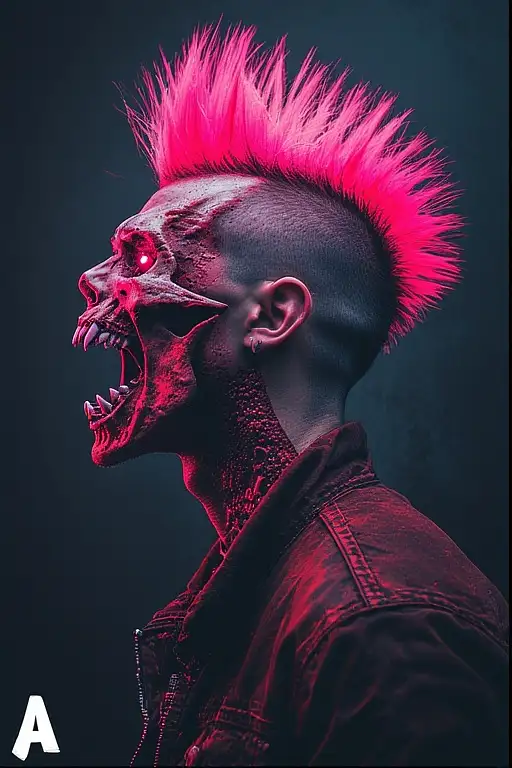
9 days ago
A punk man with a bright neon pink mohawk, shaved sides, facing sideways. His neck transforms into a demonic dragon-like red skull with sharp teeth and glowing eyes, roaring outward. The background is dark and gritty, with deep shadows and a rebellious, chaotic atmosphere. A white anarchist "A" symbol appears in the lower-left corner. The image blends photorealism with digital illustration, emphasizing punk aesthetics, rebellion, and fantasy horror elements.

9 months ago
The image features a steampunk-themed scene with a woman sitting confidently on a vintage motorcycle. She has an adventurous attire that includes a corset, gloves, and goggles, contributing to a whimsical, yet bold aesthetic typical of steampunk culture. In her right hand, she holds a pistol, adding an element of intrigue and danger. Next to her, a small dog adds a playful touch to the composition. The background showcases a large clock and an industrial setting, emphasizing the steampunk vibe with gears and a warm, sepia-toned color palette. The overall atmosphere is one of adventure and a hint of rebellion, capturing the essence of a fantastical world that blends technology with Victorian elements.
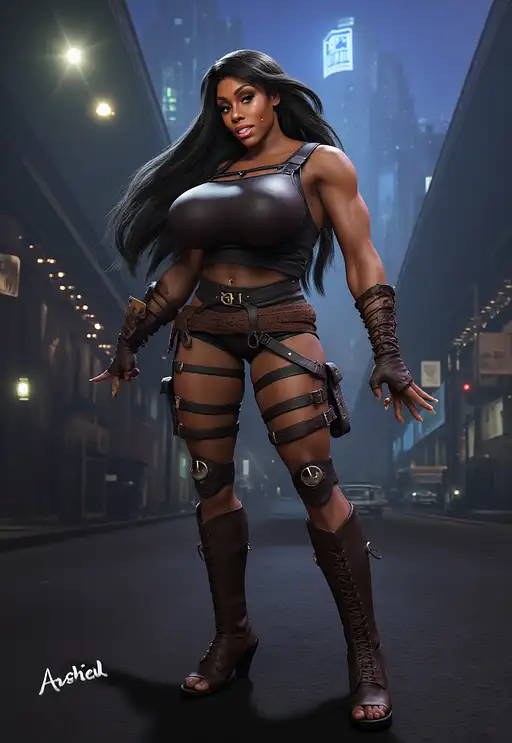
4 months ago
Create a vibrant RPG scene inspired by Final Fantasy VII, featuring Tifa Lockhart in a dynamic action pose. She stands confidently in her iconic black tank top and brown shorts, showcasing her athletic build, with her long, dark hair flowing behind her. Her gloved fists are raised, ready for combat, highlighting her martial arts prowess. The background reveals the bustling streets of Midgar, with towering steel structures and neon lights casting a moody glow. A hint of the Shinra headquarters looms in the distance, symbolizing the oppressive corporate power. Tifa's signature items, such as her leather gloves and the Materia orb glowing softly at her side, add depth to the scene. The atmosphere is charged with determination and resilience, capturing the spirit of rebellion against tyranny. Utilize a blend of anime-inspired art style and detailed textures to evoke the rich, immersive world of Final Fantasy VII.
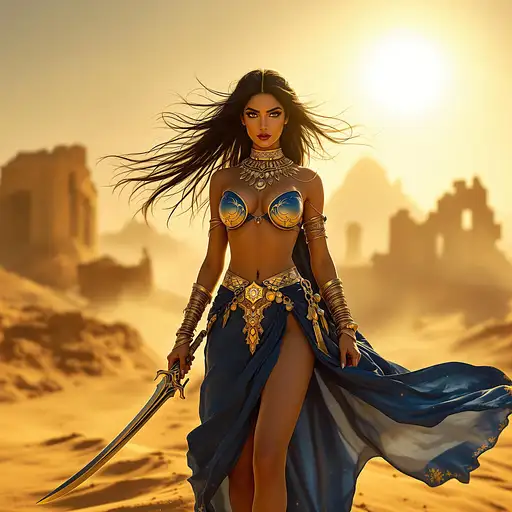
3 months ago
Epic cinematic shot of Jasmine reimagined as a rogue desert queen and freedom fighter, standing atop windswept dunes beneath a blazing sun. She wears a high-slit indigo silk cloak over jeweled gold lamellar armor, her midriff and legs exposed, glistening in the heat. Gold chains and bangles accent her curves; her kohl-lined eyes burn with seduction and rebellion. Her long jet-black hair flies in the wind, her hand resting on a twin-curved dagger. Behind her, the ruins of an empire smolder in heat haze. The light is harsh and golden, dust and motion caught mid-frame — she is both royalty and wrath.

9 months ago
"A breathtaking and surreal painting set in a wide-open desert landscape, featuring a lone biker riding a custom chopper down an empty highway. The biker, with long, flowing black hair and a red headband, wears a rugged leather jacket, jeans, and boots. His motorcycle, a gleaming chopper, boasts a polished maroon fuel tank with lightning bolt insignias, chrome details, and intricate mechanics that catch the desert light. Riding alongside him, the translucent specter of a Pony Express rider gallops at full speed atop a ghostly horse. The phantom rider, dressed in 19th-century frontier attire, including a wide-brimmed hat and a bandana, leans forward with determination as if delivering urgent mail. A leather mail pouch is slung over his shoulder, and his spectral form glows faintly against the backdrop. The horse, equally ghostly, moves with dynamic energy, its mane and tail flowing in the wind, its muscular form captured mid-stride. The desert background features towering sandstone formations and jagged cliffs, with a soft gradient of blues and oranges in the sky hinting at twilight. The painting balances the grit and rebellion of modern biker culture with the timeless and haunting spirit of the American frontier, symbolizing freedom, endurance, and a shared connection to the open road."

9 days ago
A punk man with a bright neon pink mohawk, shaved sides, facing sideways. His neck transforms into a demonic dragon-like red skull with sharp teeth and glowing eyes, roaring outward. The background is dark and gritty, with deep shadows and a rebellious, chaotic atmosphere. A white anarchist "A" symbol appears in the lower-left corner. The image blends photorealism with digital illustration, emphasizing punk aesthetics, rebellion, and fantasy horror elements.

4 months ago
Create a vibrant RPG scene inspired by Final Fantasy VII, featuring Tifa Lockhart in a dynamic action pose. She stands confidently in her iconic black tank top and brown shorts, showcasing her athletic build, with her long, dark hair flowing behind her. Her gloved fists are raised, ready for combat, highlighting her martial arts prowess. The background reveals the bustling streets of Midgar, with towering steel structures and neon lights casting a moody glow. A hint of the Shinra headquarters looms in the distance, symbolizing the oppressive corporate power. Tifa's signature items, such as her leather gloves and the Materia orb glowing softly at her side, add depth to the scene. The atmosphere is charged with determination and resilience, capturing the spirit of rebellion against tyranny. Utilize a blend of anime-inspired art style and detailed textures to evoke the rich, immersive world of Final Fantasy VII.
